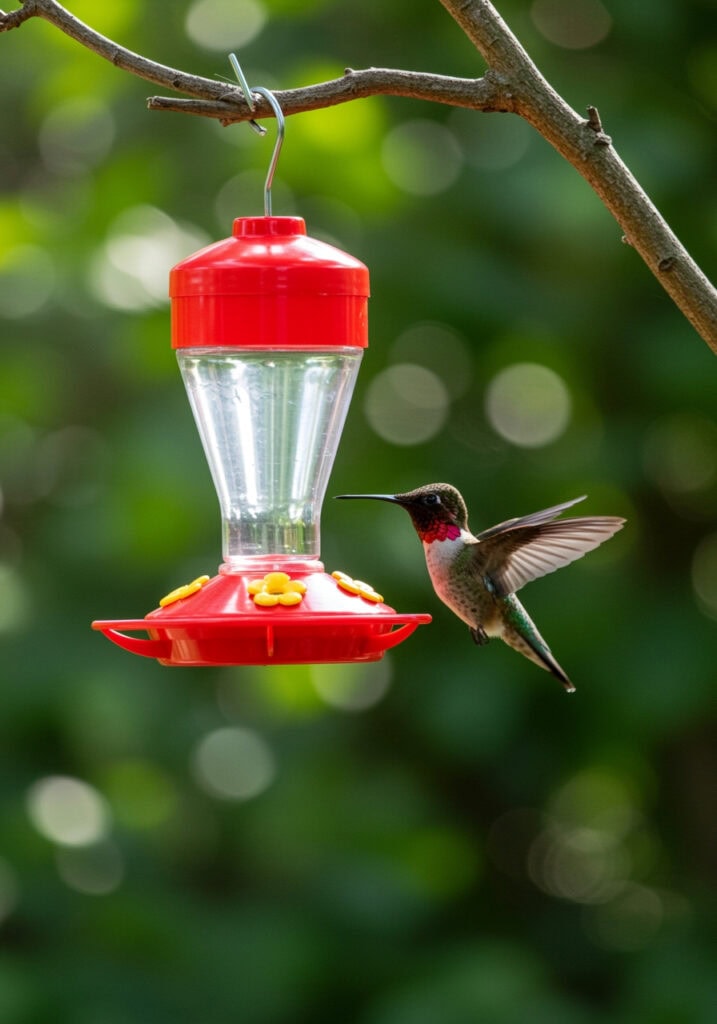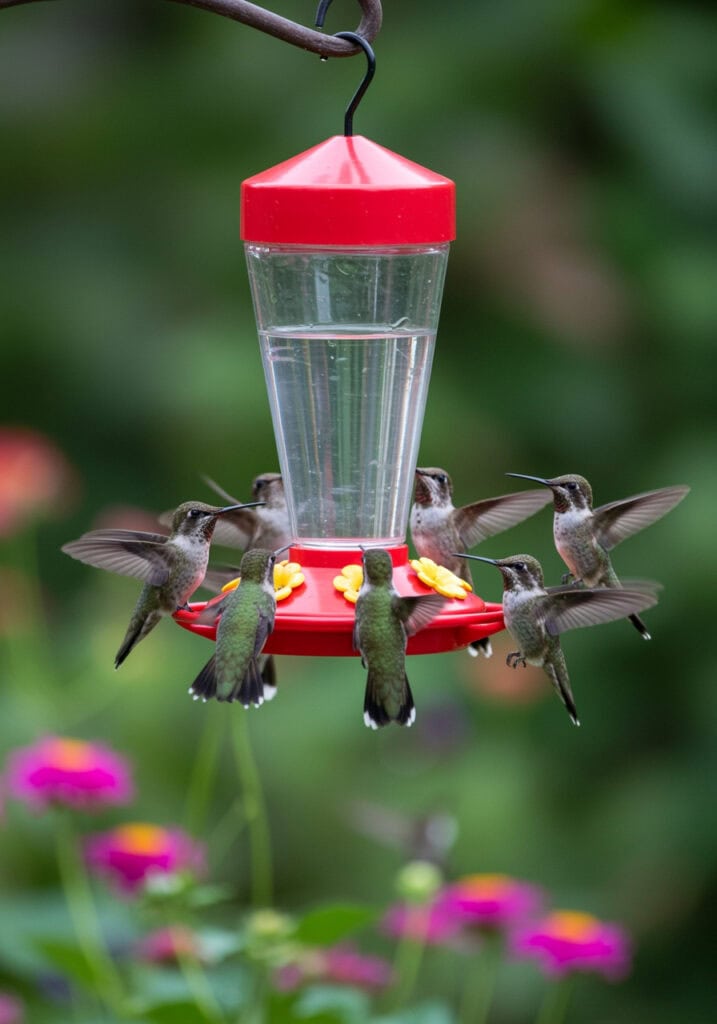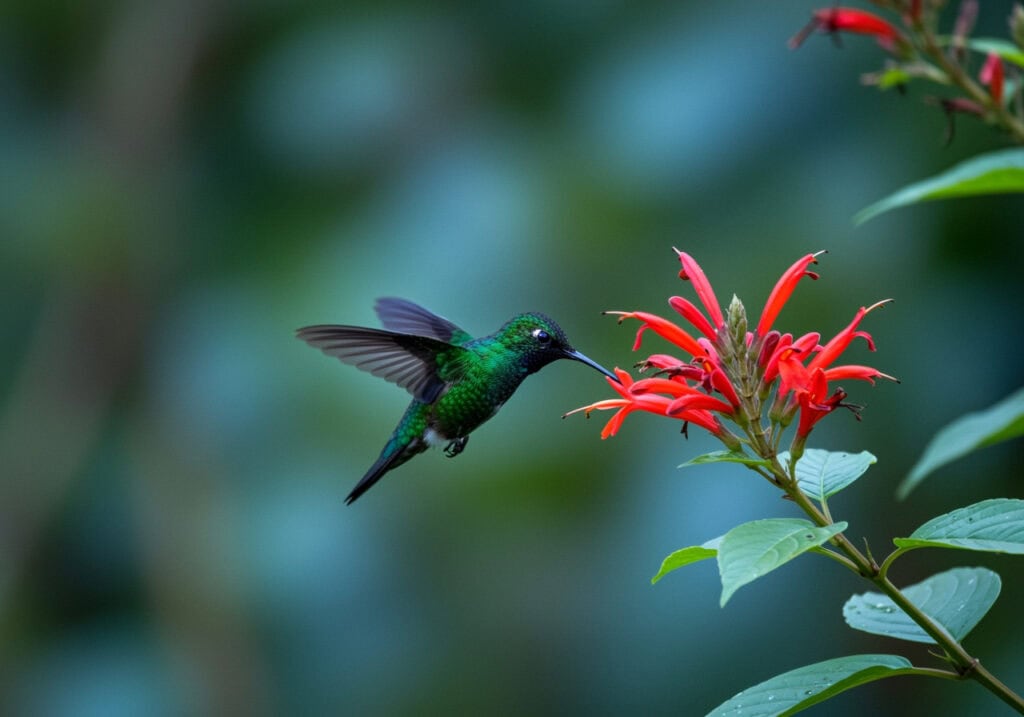Watching hummingbirds zip around your yard is pretty special, and the right nectar can turn your feeders into their favorite hangout. The best food for hummingbirds is just simple nectar made with refined white sugar and water – almost exactly like what they get from flowers. Making your own nectar is quick, and it lets you know the birds are getting something safe and healthy.
Homemade nectar helps these super-active birds as they dart from flower to flower. If you follow a good recipe, you’ll likely see more hummingbirds coming by, and you get to enjoy them up close.
Key Takeaways
- Hummingbird nectar works best with white sugar and water – nothing fancy.
- Clean feeders and good care keep the birds healthy.
- Simple, homemade nectar brings more hummingbirds to your yard.
What Is Hummingbird Nectar?
Hummingbird nectar is a sweet drink that gives these tiny birds the energy they need to keep moving. Knowing the difference between what’s in flowers and what we put in feeders helps you feed them right. You can see more about these birds here.

Natural Nectar Versus Homemade Nectar
Outside, hummingbirds sip nectar from flowers like trumpet vine, bee balm, and salvia. That flower nectar is mostly water with about 20% sugar – mostly sucrose. It gives hummingbirds quick energy, which is pretty much all they want from it.
Homemade hummingbird food tries to copy the important stuff in natural nectar. Most recipes use 1 part white sugar to 4 parts water, which is just about what’s in flowers. Skip red food dye, honey, or artificial sweeteners – they’re not good for birds. If you want more details about the right ratio and safe prep, check out this guide.
Key Components and Purpose
The main thing in hummingbird nectar, from flowers or feeders, is sucrose – plain sugar. Water helps the birds drink and use the sugar fast. This liquid food gives them the energy they need for hovering, flying long distances, and staying warm.
Hummingbird nectar doesn’t have much protein, so birds also eat tiny bugs and spiders for that. For feeders, always use plain white sugar, and boil the water first. Don’t use honey, brown sugar, or fake sweeteners. If you take care of your feeders, sugar water will give hummingbirds a safe and steady food source. For more about safe ingredients, check this nectar safety guide.
Best Hummingbird Nectar Recipe
Making your own hummingbird nectar is super easy and only takes two basic ingredients. Getting the sugar-to-water ratio right helps the birds and keeps them coming back.
Recommended Sugar to Water Ratio
The usual hummingbird nectar recipe is a 1:4 ratio – 1 part white sugar to 4 parts water. For example, use 1 cup of sugar with 4 cups of water for a standard feeder.
This ratio matches the sugar in flower nectar and gives hummingbirds the energy they need. Using more sugar can actually hurt the birds, and less sugar just won’t bring them in as much.
Don’t use anything besides plain white sugar. Skip honey, brown sugar, or artificial sweeteners – they can make the nectar spoil or even harm the birds. Tap water is fine unless it smells weird or tastes off. If it does, use filtered or bottled water instead.
Stick to the right ratio to keep your homemade nectar safe. If you’re curious about why the ratio matters, check out The Spruce’s nectar recipe guide.
Step-by-Step Preparation Guide
- Measure Ingredients
- Use 1 cup white sugar and 4 cups water, or just keep the 1:4 ratio for whatever size batch you want.
- Mix and Heat
- Put the sugar and water in a saucepan.
- Heat it on the stove, stirring until the sugar’s totally dissolved.
- Don’t let it boil a long time – once the sugar’s gone, turn off the heat.
- Cool the Nectar
- Let the nectar cool to room temperature before you fill your feeder.
- Fill and Store
- Pour the cooled nectar into a clean feeder.
- Put any extra nectar in the fridge, and use it within a week.
Clean your feeder often to keep the nectar fresh and safe. For more tips on making and storing nectar, see the instructions from Birds and Blooms.
Choosing Ingredients for Hummingbird Nectar
The best homemade nectar uses stuff that’s safe, simple, and easy for birds to digest. What kind of sugar and water you use actually matters for their health and for keeping your feeder clean.
Using White Table Sugar
Only use white table sugar for hummingbird nectar. It’s almost exactly like the natural sucrose in flowers. Other sugars – brown, powdered, or raw – aren’t safe, since they can have stuff in them that’s bad for hummingbirds.
Don’t use honey, molasses, agave, or artificial sweeteners. Honey spoils fast and can make the nectar dangerous. Fake sweeteners don’t give hummingbirds the energy they need. Always stick with plain white sugar for the best results.
Measure the sugar carefully. The right ratio is 1 part sugar to 4 parts water. For more details and tips, check the Ultimate Guide to Hummingbird Nectar. Getting the sugar right helps prevent problems like spoilage or clogging.
Selecting the Right Water
Use fresh tap or filtered water. If your tap water has a lot of chemicals (like chlorine), try bottled or filtered water. Boiling the water first helps the sugar dissolve and kills some germs. Let the nectar cool before you put it in the feeder.
Don’t use distilled water – it’s missing minerals birds need. Never use sparkling or flavored waters; those can be harmful. Once you mix the nectar, use room temp or cool water, and keep any extra in the fridge so it doesn’t spoil too fast.
Always scrub your feeder with hot soapy water between fillings to stop bacteria or mold. Clean water and feeders help keep hummingbirds healthy and the nectar fresh. For more cleaning tips, see this guide.
Proper Use and Maintenance of Hummingbird Feeders
If you want healthy hummingbirds and safe feeders, you need to pay attention to where you put your feeder, how you fill it, and how often you clean it. Using the right nectar and keeping up with maintenance keeps birds coming back and helps them stay healthy.
Filling and Placing Feeders
Fill your feeders with nectar made from 1 part white sugar to 4 parts water. Don’t use honey, brown sugar, or artificial sweeteners – they’re not safe for birds.
Put feeders in shady spots to slow down spoilage and keep the nectar cool. Don’t hang them in direct sun all day, or the nectar will go bad faster. Pick places that are easy to see but not right next to busy paths or windows, so birds don’t fly into the glass.
If you have more than one feeder, put them far enough apart so the birds don’t fight. If ants or bees show up, try using ant moats or bee guards. Clean around your feeders to keep away mold and wasps. For more advice, check out these expert tips.
Changing and Storing Nectar
When it’s hot, change the nectar every 2-3 days. If it’s cooler, you can wait 4-5 days. If the nectar looks cloudy, has floaty bits, or mold, dump it and clean the feeder right away.
Clean feeders with hot water and a bottle brush. Don’t use soap or harsh cleaners – they can leave stuff behind. If mold shows up, soak the parts in a mix of one part vinegar to four parts water, then rinse really well.
If you make extra nectar, keep it in the fridge in a closed bottle for up to a week. Always check it before refilling the feeder – make sure it’s clear and has nothing floating in it. Changing nectar and cleaning feeders will help keep hummingbirds healthy. For more on cleaning and timing, see this practical guide.
Attracting Hummingbirds to Your Yard
If you want more hummingbirds, combine good feeder placement with flowers they love. This way, you’ll see more birds and they’ll stay healthy, too.

Optimal Feeder Placement
Put your feeders where birds can see them and where they’re safe. Spots near bushes or small trees are great – hummingbirds like to perch between sips.
Hang feeders in the shade, like under tree branches or next to tall shrubs. Shade helps the nectar last longer. If you have a few feeders, don’t bunch them together, or the birds might fight.
Clean your feeders every few days, especially if it’s hot. If you see cloudy nectar or mold, change it right away. Stick to the 1 part sugar to 4 parts water mix, and never add red dye – it’s not good for the birds. For more on feeder care, check Nature’s Way Birds.
Quick Feeder Placement Tips
| Best Practices | What to Avoid |
|---|---|
| Near flowers | Full sun all day |
| Shaded spots | Windy locations |
| Close to perches | Next to windows |
Supporting Native Plants
Adding native plants to your yard helps attract more hummingbirds. Tubular flowers like bee balm, salvia, and coral honeysuckle give hummingbirds the natural nectar they need. Try to pick plants that bloom at different times, so there’s food from spring through fall.

Group the same flowers together to make a bigger target for the birds. Mix up the heights – put tall plants in the back and shorter ones up front. This setup feels safer and more welcoming for hummingbirds.
Skip the pesticides – they hurt hummingbirds and the bugs they eat. Not sure what flowers to pick? Check out Tom’s Guide on attracting hummingbirds.
Water matters too. A misting fountain or a shallow birdbath gives hummingbirds a spot to drink and clean their feathers. Little touches like this make your yard even more inviting.
Common Mistakes and Safety Tips
Some common mistakes, like using the wrong ingredients or letting feeders get dirty, can harm hummingbirds. If you stick to safe ingredients and clean your feeders often, you help keep the birds healthy and coming back.
Ingredients to Avoid
Only use white table sugar and clean water for hummingbird nectar. Don’t add food coloring, honey, or artificial sweeteners. Red dye is common in store-bought nectar, but it’s not helpful and might even hurt hummingbirds. Honey, brown sugar, agave, or maple syrup can cause fungus and are tough for birds to digest. Powdered sugar isn’t safe either since it usually has cornstarch, which isn’t good for them.
Stick with a clear mix of one part sugar and four parts water. That’s the only recipe experts recommend, and it matches what’s in real flower nectar. For more on safe ingredients, here’s a handy hummingbird nectar guide.
Best Practices for Safe Nectar
Cleanliness really matters when feeding hummingbirds. Change out the nectar every 4–5 days, or every 2–3 days if it’s hot. Old nectar can spoil, get moldy, or ferment, and that’s risky for the birds.
Each time you refill, wash the feeder with hot water and a little brush. Don’t use strong soap, and skip the bleach unless there’s a lot of mold. Rinse it well so nothing’s left behind. If you notice cloudy nectar, black spots, or a sour smell, clean it right away.
Store extra nectar in the fridge, but make a fresh batch every couple of weeks. If it’s freezing outside, bring the feeder in at night. Shade helps keep nectar cool on hot days. Following these best practices keeps hummingbirds coming back and staying healthy.
Frequently Asked Questions
What is the ideal sugar to water ratio for homemade hummingbird nectar?
The best ratio is 1 part white sugar to 4 parts water. This is closest to what hummingbirds find in flowers and keeps them healthy. If you use a different ratio, you might end up with fewer birds or even cause health problems.
Learn more about the proper nectar ratio here.
Can you provide a simple recipe for making hummingbird nectar at home?
Mix 1 cup of white sugar with 4 cups of hot water. Stir until the sugar dissolves. Let it cool before you fill the feeder.
Don’t add honey, artificial sweeteners, or food coloring—those can harm the birds. You can find detailed instructions and important safety notes in this homemade hummingbird nectar recipe guide.
How often should I change the hummingbird nectar in feeders?
Change the nectar every 2-3 days, especially when it’s warm. If it’s cooler, you can go every 3-5 days, but don’t wait longer than that.
Swapping out the nectar stops fermentation, bacteria, and mold. For more advice, here are some feeder cleaning and nectar freshness tips.
What is the best way to prevent mold in hummingbird nectar?
Clean feeders with hot soapy water every time you refill them. Rinse well and let them dry before you add new nectar.
Never let old nectar sit for more than a few days. Cleaning feeders often can stop mold growth.
Are there any natural alternatives to using plain sugar in hummingbird nectar?
Only plain white sugar is safe for hummingbirds. Don’t use brown sugar, honey, or artificial sweeteners – they can be bad or even toxic for birds. Natural flower nectar is best, but if you supplement, just stick to white sugar and water.
Find more about safe nectar ingredients at Hummingbird Nectar 101.
How can I attract more hummingbirds to my backyard feeders?
Put your feeders where there’s some sunlight, but not too much wind. Hummingbirds really like red, so pick feeders with bright red parts.
Change the nectar often and wash your feeders to keep them safe for birds. Plant some native flowers nearby for extra food. If you want more tips, check out this guide to attracting hummingbirds.